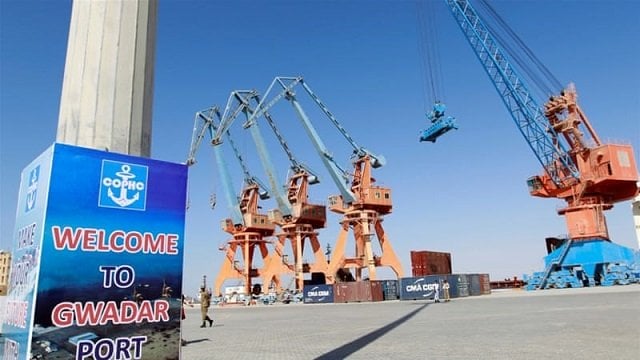
Imports in January 2018, reported by the Pakistan Bureau of Statistics (PBS), were more than 25% higher, in rupee terms, than the imports reported in January 2017.
Although exports increased by more than 17% over the same period, the increase in imports has adversely impacted the trade deficit by more than 31%. It is expected that the deficit in FY18 will rise further.
The deficit was more than 10% of GDP in FY17. However, the government has recently provided relief packages to the exporters to boost exports.
Large-scale manufacturing (LSM), as reported by the State Bank of Pakistan, rose 5.55% between July and December FY18 compared to 3.9% in the same period of FY17.
However, the biggest gains are not reported in the export-oriented textile, leather and food and beverages industries, but in the import-dependent automobile, electronics, iron and steel as well as coke and petroleum industries.
Export package termed short-term solution
These industries are the biggest beneficiaries of CPEC-related infrastructure projects. Sustainable export growth must accompany infrastructure development in order to restrict the increase in trade deficit.
A cross-country comparison of large domestic markets within the region using the data available at ITC’s ‘trademap.org’ suggests that exports declined across the region between 2013 and 2016.
Imports by India have also declined by more than 23% over the same period. This is primarily due to fall in imports of mineral fuels and precious and semi-precious stones, which have decreased by more than 50%.
The change in the value of imports into Pakistan between 2013 and 2016 was also a result of fall in prices of mineral fuels, but the increase in the import value of machinery and electrical appliances offset the decline in imports. There has been a shift in the import pattern of Pakistan, which is reflected in the LSM index.
Industrial transformation
It is a well-known fact that several of the larger regional countries have undergone major industrial transformation since the 1980s. According to the National Accounts Main Aggregates Database of the UN statistics division, China exported goods worth less than 10% of GDP until the late 1980s.
Exports were more than one-third of GDP in the mid-2000s. It was at 20% in 2016 primarily due to the global recession.
Exports, as a percentage of GDP for India, surpassed 20% between 2006 and 2014. Bangladesh has reported a ratio of more than 16% since 2005.
On the other hand, exports, as a percentage of GDP, were higher for Pakistan than they were for India and Bangladesh until the late 1990s. The ratio increased for Pakistan in the mid-2000s, but has decreased since 2013.
It was reported at 8.7% in 2016, the lowest since 1986. This clearly suggests that viable export policies are the need of the hour.
The spike in imports, as a percentage of GDP, was first reported by Pakistan in 2005, when it imported goods worth more than 18% of GDP. Although imports into Pakistan have grown exceptionally in the last few years, their proportion to the GDP is below that of India and Bangladesh.
Considering the data on national accounts, Pakistan has maintained exceptionally high levels of final consumption expenditure as a percentage of GDP that has exceeded 88% since 1970 - starting point of the dataset. In recent years, it is reported to be above 90%.
On the other hand, India has managed to reduce it from 88% in 1970 to below 70% in recent years. Since 2001, it has averaged 68.9% for India.
Furthermore, with an average of 60% from 1970 to the present, China reported less than 50% in 2008.
Gross fixed capital formation as a percentage of GDP for Pakistan has been significantly lower relative to Bangladesh, India and China. Low levels of investment and high rates of consumption in Pakistan are likely to have contributed to the ballooning trade deficit today.
Major import goods
One of the biggest contributors to the machinery group is power generating machinery. Its value of imports exceeded $1.6 billion in FY17. This was approximately one-fifth of total imports in the machinery group. On the other hand, there has been a sharp increase in the imports of electrical machinery and apparatus in FY18. In the first seven months, they have already surpassed the total value reported for FY15.
Pakistan's IT sector advancing rapidly as exports jump to $5b
Although it may be too early to determine whether it is due to an increase in demand from the manufacturing sector, it does coincide with the increase in the respective sectors in the LSM index.
With imports continuously increasing at a faster rate than exports, the rise in the trade deficit will likely continue to persist. It is imperative that the government adopt effective policies to boost exports.
A more holistic approach needs to be adopted than selective policies that provide subsidies to the larger stakeholders within the traditional export-oriented industries.
For instance, potential exporters, in traditional and non-traditional industries, must be identified that have the knowledge and skills to produce exportable products but lack capital and face trade obstacles.
Furthermore, obtaining favourable exchange rate valuations are often a challenge for the exporters, so they must focus on improvement of the quality of their products that are less sensitive to price competition.
In essence, industrialisation strategies must reduce the dependence of exporters on short-term relief packages to boost their exports.
The writer is Assistant Professor of Economics and Research Fellow at CBER, IBA
Published in The Express Tribune, March 5th, 2018.
Like Business on Facebook, follow @TribuneBiz on Twitter to stay informed and join in the conversation.






1719053250-0/BeFunky-collage-(5)1719053250-0-270x192.webp)










COMMENTS
Comments are moderated and generally will be posted if they are on-topic and not abusive.
For more information, please see our Comments FAQ